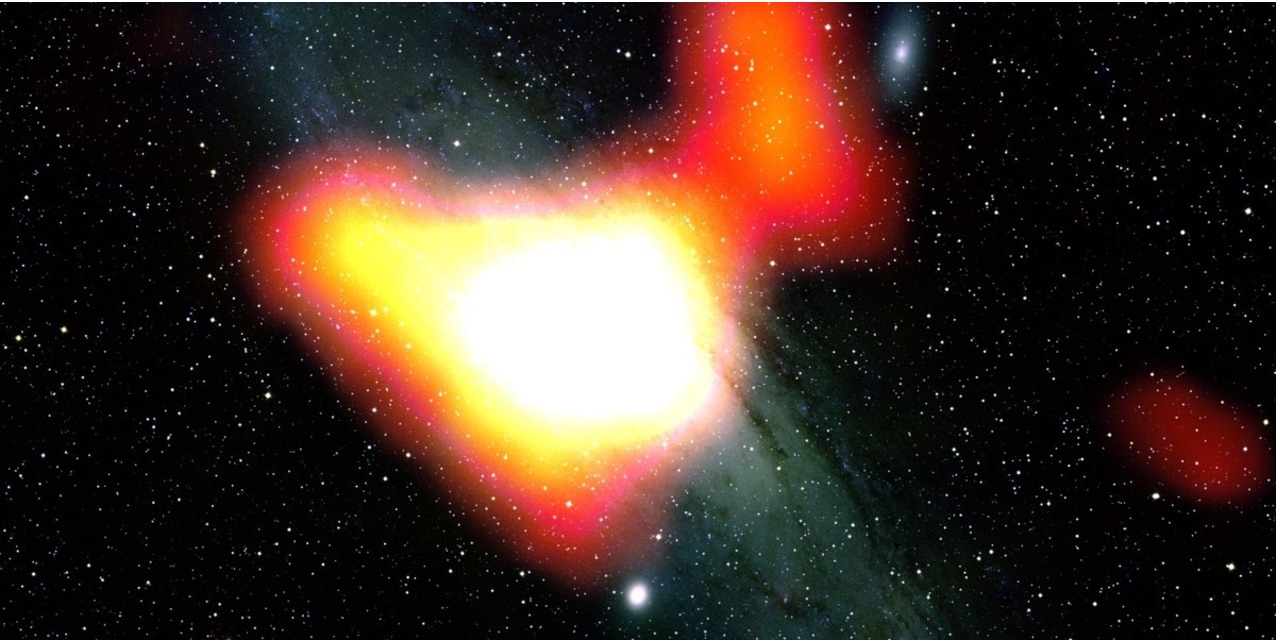The Andromeda Galaxy Could Be Buzzing With Dark Matter

There's something peculiar going on in the core of Andromeda, the Milky Way galaxy's nearby cousin.
Using NASA's Fermi Gamma Ray Observatory, astronomers have been able to detect a powerful source of gamma-ray radiation emanating from Andromeda and it could be the fingerprint of one of the biggest mysteries hanging over modern cosmology.
The gamma-ray emissions could be generated by the annihilation of dark matter particles and a similar signal has been detected coming from our own galaxy.
Dark matter constitutes nearly 85 percent of all mass in the universe (and normal matter — all visible stuff — therefore accounts for only 15 percent of all matter), but because it doesn't interact with the electromagnetic force, i.e. light, we cannot directly "see" it. We can, however, indirectly detect it by observing its gravitational effects on normal matter on galactic and cosmological scales.
The only problem is that we don't know what "it" is. But this new Fermi observation may bring us one step closer.
RELATED: 'Axion-like Particles' Probably Not a Dark Matter Answer
Astrophysicists know that galaxies emit gamma-rays, but to have such a powerful gamma-ray signal coming from the center of Andromeda means something strange is going on.
Get the Space.com Newsletter
Breaking space news, the latest updates on rocket launches, skywatching events and more!
"We expect dark matter to accumulate in the innermost regions of the Milky Way and other galaxies, which is why finding such a compact signal is very exciting," said astrophysicist Pierrick Martin, of the National Center for Scientific Research and the Research Institute in Astrophysics and Planetology in Toulouse, France.
It is thought that when dark matter particles, such as hypothesized weakly-interacting massive particles (or WIMPS), collide, they annihilate, releasing a sudden burst in energy. This energy is in the form of gamma-rays, so where Fermi sees an intense gamma-ray emitting region, it could indicate the location of a dense cloud of dark matter.
There could be another explanation, however. The researchers point out that a dense accumulation of pulsars could also generate an intense gamma-ray signal, but Andromeda is 2.5 million light-years away, so there's no way to resolve individual pulsar sources of gamma-rays.
RELATED: 'Dead' Galaxy May Hide Dark Matter Surprise
But as we know the Milky Way also generates gamma-ray radiation in its core, the researchers hope to compare the signal from Andromeda and the Milky Way to hopefully reveal if the signal is being caused by pulsars (that we can resolve in our own galaxy) or, more excitingly, dark matter particles annihilating in the cores of both galaxies.
"Our galaxy is so similar to Andromeda, it really helps us to be able to study it, because we can learn more about our galaxy and its formation," said research scientist Regina Caputo at NASA's Goddard Space Flight Center in Greenbelt, Maryland. "It's like living in a world where there's no mirrors but you have a twin, and you can see everything physical about the twin."
RELATED: Did Dark Matter Kill The Dinosaurs?
Originally published on Seeker.
Join our Space Forums to keep talking space on the latest missions, night sky and more! And if you have a news tip, correction or comment, let us know at: community@space.com.
Ian O'Neill is a media relations specialist at NASA's Jet Propulsion Laboratory (JPL) in Southern California. Prior to joining JPL, he served as editor for the Astronomical Society of the Pacific‘s Mercury magazine and Mercury Online and contributed articles to a number of other publications, including Space.com, Space.com, Live Science, HISTORY.com, Scientific American. Ian holds a Ph.D in solar physics and a master's degree in planetary and space physics.












